Understanding the Ledger Indexing
- Home
- World War I Articles
- Understanding the Ledger Indexing
This article aims to set out some of the technical aspects of the indexing of - and subcategories that make up - the 'ledgers' in The Western Front Association's collection of Pension Record Cards.
These ledgers have been scanned and digitised by our partner, Ancestry.co.uk and are available on their fold3 website. These are now available for WFA members to access via the WFA web site. An article looking at examples of these ledgers can be found HERE> A Further Release of First World War Pension Records by Ancestry.
The ledgers within this archive comprise in excess of 1.5 million records of men who served in the British Army, The Royal Navy, and RFC/RAF during the Great War and who claimed a pension (or, if they were killed in the conflict, their relatives claimed a pension).
These records show signs of having been 'weeded' at some stage - probably after the second world war, but still is a remarkably intact set of records.
The ledgers in their original form are a series of numerically sequenced books (totalling in excess of 15,000 books) each book contains 100 pages with each page representing one pension claim.
These 15,000 books are divided unequally into the following sets:
- Disabled Soldiers, Naval Ratings and Airmen
- Widows
- Dependents
- APD cases (Alternative Pension: Disablement)
- APW cases (Alternative Pension: Widow)
Some of these subcategories were then further subdivided by region (thirteen regions were seemingly planned, only ten were allocated). One region (region 11) developed its own code rather than following the standard pattern, and some of the ledgers were 'recycled' with the original reference number (see below) re-allocated to a totally different sub-category.
Once a ledger was written for an individual, an index card was created detailing the unique reference number for the ledger. These index cards were then filed alphabetically in different 'runs' – the run depending on the type of ledger that the card was used to index. These cards are fully intact, but the weeding of the ledgers means that not all cards will lead to a ledger.
The cards - which were produced after the ledgers - were effectively 'finding aids' to locate the ledger which was in turn used to summarise post-award correspondence as well as the results of medical-board examinations. The cards (which will be published in various stages during 2019 by Ancestry) provide different levels of detail, and (especially for those combatants who were killed) sometimes provide more detail than the ledger.
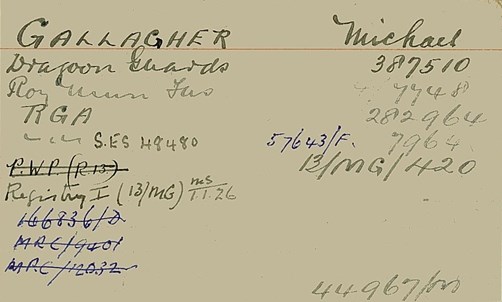
Fig 1: A Card for a soldier who survived (Michael Gallagher). Note 13/MG/420 on the card
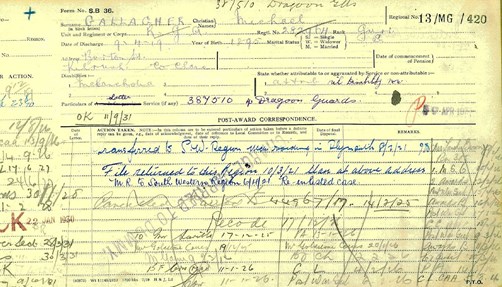
Fig 2: The corresponding Ledger for Michael Gallagher. The Ledger was pre-printed with 13/MG/420 which was then transposed onto his card in Figure 1.
Although each of the various sets of ledgers in these sub categories are on the face of it quite similar, they provide differing types of detail.
Disabled
The 'disabled' sets comprise approximately 12,000 ledgers (1.2 million individuals) which represents over 80% of this archive. These 'disabled' ledgers arguably provide more significant detail than the other sets.
When fully completed by the Ministry of Pensions clerk, these ledgers give the soldier's name, regimental, number, rank, date of discharge, year of birth, marital status, address, disabilities (and whether these are attributable to, aggravated by, or non-attributable to his war service). Also - on the reverse - are often details of the post war medical boards at which the individual's disability was reviewed. These reviews all seem to cease in the early 1920s but do provide an indication of the level of infirmity the serviceman suffered from post-war.
The indexing of this subcategory can be summarised as follows
The ledgers were planned to be divided into 13 regions (depending on the claimant's address). Regions 9 and 10 were not allocated and instead merged into region 11. Therefore the first number on the ledger represents the geographic area of the UK the claimant lived in as follows
Region 1 – Scotland
Region 2 – Northern
Region 3 – North West
Region 4 – Yorkshire
Region 5 – Wales
Region 6 – West Midlands
Region 7 – East Midlands
Region 8 – South West
Regions 9 and 10: Eastern and Metropolitan not allocated - seemingly merged into Region 11
Region 11 – Eastern / Metropolitan /South East [not in existence: must have been destroyed]
Region 12 – Ulster
Region 13 – Southern Ireland
NOTE: To assist with the identification of counties and how they are located in the above regions, please review the index in the following article: Index of counties within regions for Pension Records
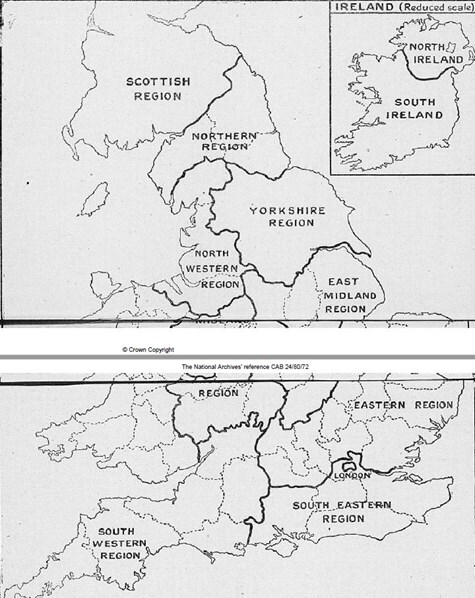
Above: Map from 'War Pension Gazette' dated May 1919. My thanks to Craig Suddick for providing this. Original image (c) The National Archives CAB/24/80/72
The next part of the index from the disabled set is a one or two letter code. For those claimants who served in the army, the first letter is M (for Military) and the second letter is the first letter of the individual's surname. There then is a number which is the consecutive numbered page within the ledger.
The number in the first ledger for the Scottish region is 1/MA/001 was allocated to a Private James Anderson of the MGC. This book runs to 1/MA/100. The subsequent book commences at 1/MA/101 and runs to 1/MA/200, and so on. The first book in the next sequence (1/MB/001 to 1/MB/100) covers one hundred individuals with a surname starting with 'B'. These surnames range (alphabetically) from Baddon to Byrne.
It should be noted that the pages in the ledgers are not compiled in an alphabetical sequence, so the use of the index cards (mentioned above) was vital to assist the clerks locate the ledgers.
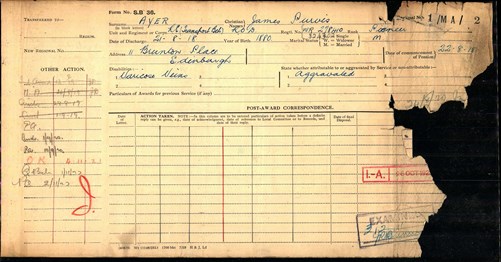
Above: Ledger reference 1/MA/2 being the second ledger in the sequence 1/MA/001 to 1/MA/100 is for a soldier called Ayer, showing the random way the ledgers were 'alphabetically' compiled ! The damage to this ledger is due to it being one of the first pages in the first book of a sequence. It is likely that during the course of the hundred years since it was created it was probably at the start of a shelf and consequently suffered more than other ledgers as a result.
The number of books in each sequence depended on the number of men whose with surnames commenced with A, B, C etc. An example of this is for the sequence 1/MM/ (Scottish region, men whose surnames commenced with the letter 'M') - we have here lots of Macs and Mcs - there being 331 books (each with 100 pages) of men with a surname starting with 'M'.
For Naval or Airforce claimants, the after the regional number will appear either 'N' for Navy or 'AF' for Airforce. There is no coding for these sailors or airmen to tie in with the individuals surname.
Therefore 13/AF/1234 would be an Airman from Southern Ireland, and 5/N/4321 could be a Naval Rating from Wales.
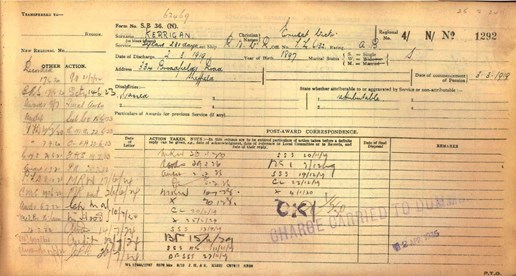
Fig 3: A card for a sailor - Ernest Kerrigan - from Sheffield (therefore region 4) who served in the Royal Naval Division: '4/N/1292' being the ledger reference.
It should be noted that Region 11's ledgers have not survived having probably been weeded by the MoD in the period after the Second World War.
Widows
This set comprises about 650 ledgers (65,000 individuals). Again they are split regionally and all regions except the un-allocated 9 and 10 are present. The largest single region is region 11 with over one-third of the entire widows' records. This suggests that (assuming the proportion of region 11 records was the same for the Disabled Soldiers, Naval Ratings and Airmen), approximately 19,000 ledgers (1.9 million individuals) from region 11 have been weeded from the Disabled Soldiers, Naval Ratings and Airmen set.
The coding of these records is in the format of Region / W (for Widow) / sequence number.
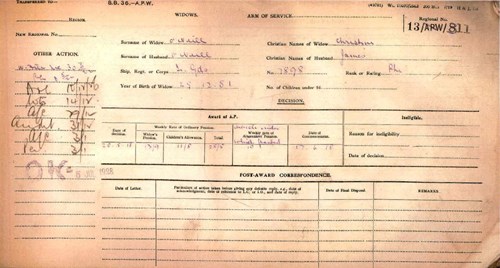
Fig 4: The ledger for the widow of James O'Neil. This is an example of the 'recycling' of a ledger mentioned above. It is - on face value an APW case (see below for APW) but in truth this ledger was allocated the number 13/W/311 (the 811 had been altered to 311 and the AP crossed out to leave just the W.
Dependents
This set comprises some 2,300 ledgers (230,000 individuals). All regions are represented. They are coded Region / D (for Dependents) / sequence number (but see below for the anomaly for region 11) .
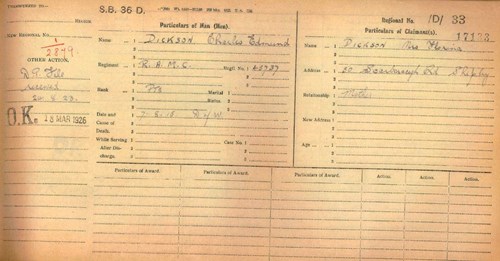
Fig 5: The 'dependents' ledger for the claimant Florina Dickson (of 50 Scarborough Road, Shipley) the mother of Charles Edmund Dickson. The ledger here has not been fully completed by the clerk. The 'true' reference number had it been completed would have been 4/D/17133.
The soldier here was the great uncle of TV presenter Jeremy Paxman.
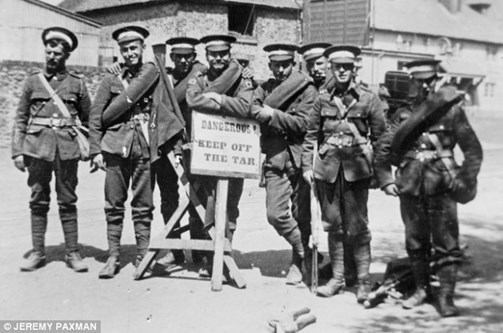
Above: Jeremy Paxman's great-uncle Charlie Dickson, smiling in the middle, arms folded, leaning on a road sign, with his comrades in 1915. Courtesy Daily Mail online / Jeremy Paxman
There is, however one major anomaly within the 'Dependents' sub-category. If it had followed the other regions, we would have expected region 11 (Eastern/London/South East) to have had its records coded (for example) 11/D/12345. However - for reasons that will probably never be known - region 11's 'Dependents' ledgers are coded 'PP' instead of 'D' - so we have (using the same example) 11/PP/12345. This sub-category (viz. 11/PP) runs to over 66,800 individual entries making it - by some distance - the largest geographical area within the 'Dependents' sub-category.
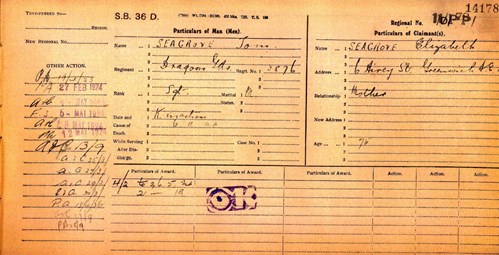
Fig 7: An example of an 11/D ledger (for Sgt John Seagrove, 3876 Dragoon Guards kia 6/11/1914). The coding on this would have been 11/D/14178 but has been super-imposed with the prefix 11/PP making the full reference 11/PP/14178.
APD and APW
There are some regions missing for these 'Alternative cases. For 'APD', regions 5, 8, 11, 12 and 13 (being Wales, South West, South East, Ulster and Southern Ireland) seem to have been weeded. Similarly for the 'APW' set, regions 8 and 11 do not exist.
APD contains approximately 80 ledgers (8,000 records) and APW some 340 ledgers (34,000 records).
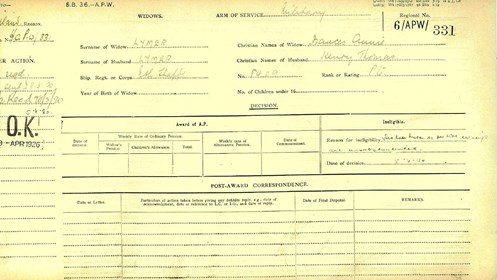
Fig 7: An 'APW' ledger - this application having been rejected. As the 'Alternative' Pensions were to be paid instead of the existing pension, there would normally be two ledgers in these cases - one for the 'original' payment and another for the 'alternative' pension which may or may not have been agreed.
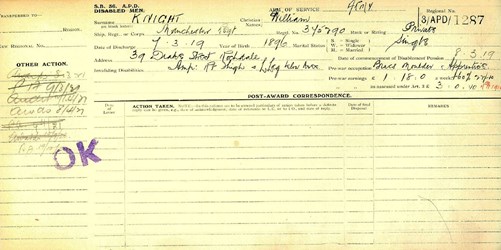
Fig 8: The 'APD' ledger for William Knight
The payment of these 'alternative pensions' is complicated. In summary there seems to have been two schemes that disabled veterans (or their widows) could apply for in certain circumstances. The APD scheme seems to have been designed to grant to successful applicants (specifically the disabled soldier) a larger pension to take account of his not being able to earn as much as he did prior to the war. The APW scheme similarly seems to have been an attempt to boost the widow's income. The fact that these two schemes were not particularly well taken-up is something that would be a very interesting subject for academic study.
David Tattersfield
The examples of the Pension ledgers in this article have been extracted from the WFA's Pension Archive. This archive is available for WFA members to access > HERE The Western Front Association Digitised Pension Records
Further reading:
- Great War Pension Records : deeper understanding
- Pension Record Cards and Ledgers: some examples of dependents' cards
- A Further Release of First World War Pension Records by Ancestry
- 'One Hell of a Row': A War widow's pension
- Finding Great Uncle George
- Dear David ... Pension Record Cards Feedback
- Release of Naval and Mercantile Marine Pension Records by Ancestry
- Pension Records: Famous, Infamous, Extraordinary and Ordinary
- Pension Record Cards - claims for soldiers who were killed





